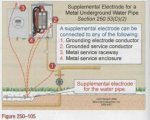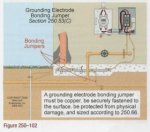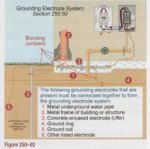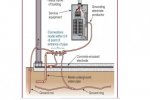Can somebody please tell me in the code book were it states that only the first GEC has to be continuous, I had a Inspecter quote 250.64(c), I tried looking in the NEC were it states only the first one has to be continuous, Yesterday I had to rerun my whole GES,
You are using an out of date browser. It may not display this or other websites correctly.
You should upgrade or use an alternative browser.
You should upgrade or use an alternative browser.
Continuous
- Thread starter SAP
- Start date
- Status
- Not open for further replies.
- Location
- Illinois
- Occupation
- retired electrician
Give us a more complete description of how you installed the GEC.
Where did you get the idea only the first GEC had to be continuous? With only a couple few exemptions, all GEC's must be continuous. If you are referring to GE bonding jumpers, there are only a few places you are permitted to extend the GES from without starting another GEC from the grounded service-entrance conductor.Can somebody please tell me in the code book were it states that only the first GEC has to be continuous, I had a Inspecter quote 250.64(c), I tried looking in the NEC were it states only the first one has to be continuous, Yesterday I had to rerun my whole GES,
- Location
- Placerville, CA, USA
- Occupation
- Retired PV System Designer
Related, however, is the statement that you can see in Mike Holt presentations that where you have multiple electrodes in the GES some of the wires may be bonding jumpers rather than GECs.
And bonding jumpers are not required to be continuous.
And bonding jumpers are not required to be continuous.
From service 2/0 wire , I hit my water first #4, Put another ground clamp on water #6 to ground rod, put another ground clamp on water and bonded my gas # 6 I know that gas is not a GEC, I thought after my water I could just use ground clamps to run over to my ground rod, he wanted no break in the wire
- Location
- Placerville, CA, USA
- Occupation
- Retired PV System Designer
IMHO he is wrong.
- Location
- Illinois
- Occupation
- retired electrician
That meets the requirements of the NEC. Only the #4 to the water pipe is a GEC, the rest are bonding jumpers.From service 2/0 wire , I hit my water first #4, Put another ground clamp on water #6 to ground rod, put another ground clamp on water and bonded my gas # 6 I know that gas is not a GEC, I thought after my water I could just use ground clamps to run over to my ground rod, he wanted no break in the wire
- Location
- Bremerton, Washington
If you could get a copy of Mike Holts Grounding vs Bonding, it has very detailed graphics that show clearly what you are asking. If I have time I may be able to post a graphic later.
electrofelon
Senior Member
- Location
- Cherry Valley NY, Seattle, WA
Can somebody please tell me in the code book were it states that only the first GEC has to be continuous, I had a Inspecter quote 250.64(c), I tried looking in the NEC were it states only the first one has to be continuous, Yesterday I had to rerun my whole GES,
I think the statement you are looking for is something like, "the GEC only has to be continuous to the first electrode." But that isn't really correct, because the GEC ends at the first electrode.
I agree that only run to 'first' GE has to be continuous.
but MH questioned using additional ground clamp as the correct connection of supplemental electrode because it is not on a list in 250.53(D)(2)
but MH questioned using additional ground clamp as the correct connection of supplemental electrode because it is not on a list in 250.53(D)(2)
From service 2/0 wire , I hit my water first #4, Put another ground clamp on water #6 to ground rod, put another ground clamp on water and bonded my gas # 6 I know that gas is not a GEC, I thought after my water I could just use ground clamps to run over to my ground rod, he wanted no break in the wire
Attachments
If you could get a copy of Mike Holts Grounding vs Bonding, it has very detailed graphics that show clearly what you are asking. If I have time I may be able to post a graphic later.
those graphics?
MH still avoids connection of supplemental electrode using additional water clamp.
Attachments
MH still avoids connection of supplemental electrode using additional water clamp.
I'm not sure what you mean, see the illustration below.

Roger
Your graphic is from 2005 and mine from 2008. Maybe he changed that in between. Or I may be wrong. I'm still learning here.
My understanding is Grounding Electrode is not on a list in 250.53 D2
Mike's illustrations are examples and do not cover every possibility.
Here is an illustration from the 2014 NECH.
Attachments
Brian Dang
Member
- Location
- Burbank, Ca, US
put another ground clamp on water and bonded my gas # 6 I know that gas is not a GEC,
Gas piping is not allowed for grounding electrode.
- Location
- New Jersey
- Occupation
- Journeyman Electrician
Gas piping is not allowed for grounding electrode.
He stated that he bonded the gas piping he's not using it as an electrdoe.
Code compliant.He stated that he bonded the gas piping he's not using it as an electrdoe.
(Fault electrons can distinguish when it is an electrode and not. :happyno
jumper
Senior Member
- Location
- 3 Hr 2 Min from Winged Horses
Code compliant.
(Fault electrons can distinguish when it is an electrode and not. :happyno
Brian Dang
Member
- Location
- Burbank, Ca, US
He stated that he bonded the gas piping he's not using it as an electrdoe.
Thank you. So the Gas people want to have a zero potential between the electrical power distribution (enclosure/raceway) and the gas piping to prevent shock hazard, but the Electrical folks don’t want lightning current to flow in the gas pipe that might ignite it (can not be used as grounding electrode). They want the gas pipe to be bonded to the grounding electrode, but what happens if the lightning current sees a lower impedance to the gas pipe as compare to the grounding rod + cold water pipe? Can this condition exist?
A case study. A service panel was grounded to the grounding rod right below it, and a cold water pipe 10 ft away from the grounding rod. A gas pipe is 3.5 ft away from the grounding rod was bonded to the rod. Lightning current might find the gas pipe having smaller impedance path, and fried it. What should the electrician do?
- Occupation
- Licensed Electrician
The NEC has essentially nothing to do with lightning protection.Thank you. So the Gas people want to have a zero potential between the electrical power distribution (enclosure/raceway) and the gas piping to prevent shock hazard, but the Electrical folks don’t want lightning current to flow in the gas pipe that might ignite it (can not be used as grounding electrode). They want the gas pipe to be bonded to the grounding electrode, but what happens if the lightning current sees a lower impedance to the gas pipe as compare to the grounding rod + cold water pipe? Can this condition exist?
A case study. A service panel was grounded to the grounding rod right below it, and a cold water pipe 10 ft away from the grounding rod. A gas pipe is 3.5 ft away from the grounding rod was bonded to the rod. Lightning current might find the gas pipe having smaller impedance path, and fried it. What should the electrician do?
- Status
- Not open for further replies.





